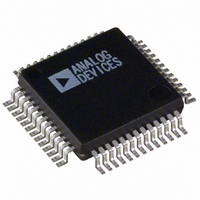ADUC834BSZ Analog Devices Inc, ADUC834BSZ Datasheet - Page 67

ADUC834BSZ
Manufacturer Part Number
ADUC834BSZ
Description
IC ADC DUAL16/24BIT W/MCU 52MQFP
Manufacturer
Analog Devices Inc
Series
MicroConverter® ADuC8xxr
Specifications of ADUC834BSZ
Core Size
8-Bit
Program Memory Size
62KB (62K x 8)
Oscillator Type
Internal
Core Processor
8052
Speed
12.58MHz
Connectivity
EBI/EMI, I²C, SPI, UART/USART
Peripherals
POR, PSM, PWM, Temp Sensor, WDT
Number Of I /o
34
Program Memory Type
FLASH
Eeprom Size
4K x 8
Ram Size
2.25K x 8
Voltage - Supply (vcc/vdd)
2.7 V ~ 5.25 V
Data Converters
A/D 3x16b, 4x24b; D/A 1x12b
Operating Temperature
-40°C ~ 125°C
Package / Case
52-MQFP, 52-PQFP
Controller Family/series
(8052) ADUC
No. Of I/o's
26
Eeprom Memory Size
62KB
Ram Memory Size
2KB
Cpu Speed
12.58MHz
Package
52MQFP
Device Core
8052
Family Name
ADuC8xx
Maximum Speed
12.58 MHz
Operating Supply Voltage
3.3|5 V
Data Bus Width
8 Bit
Number Of Programmable I/os
26
Interface Type
I2C/SPI/UART
On-chip Adc
4-chx16-bit|4-chx24-bit
On-chip Dac
1-chx12-bit
Number Of Timers
3
Lead Free Status / RoHS Status
Lead free / RoHS Compliant
Available stocks
Company
Part Number
Manufacturer
Quantity
Price
Company:
Part Number:
ADUC834BSZ
Manufacturer:
TOSHIBA
Quantity:
1 200
Company:
Part Number:
ADUC834BSZ
Manufacturer:
Analog Devices Inc
Quantity:
10 000
Part Number:
ADUC834BSZ
Manufacturer:
ADI/亚德诺
Quantity:
20 000
OTHER HARDWARE CONSIDERATIONS
In-Circuit Serial Download Access
Nearly all ADuC834 designs will want to take advantage of the
in-circuit reprogrammability of the chip. This is accomplished
by a connection to the ADuC834’s UART, which requires an
external RS-232 chip for level translation if downloading code
from a PC. Basic configuration of an RS-232 connection is
illustrated in Figure 66 with a simple ADM3202-based circuit.
If users would rather not include an RS-232 chip onto the target
board, refer to the application note uC006–A 4-Wire UART-to-PC
Interface available at www.analog.com/microconverter, for a
simple (and zero-cost-per-board) method of gaining in-circuit
serial download access to the ADuC834.
In addition to the basic UART connections, users will also need
a way to trigger the chip into Download mode. This is accom-
plished via a 1 kΩ pull-down resistor that can be jumpered onto
the PSEN pin, as shown in Figure 66. To get the ADuC834 into
Download mode, simply connect this jumper and power-cycle
the device (or manually reset the device, if a manual reset button
is available) and it will be ready to receive a new program serially.
With the jumper removed, the device will power-on in Normal
mode (and run the program) whenever power is cycled or RESET
is toggled.
Note that PSEN is normally an output (as described in the
External Memory Interface section) and it is sampled as an input
only on the falling edge of RESET (i.e., at power-up or upon an
external manual reset). Note also that if any external circuitry
unintentionally pulls PSEN low during power-up or reset events,
it could cause the chip to enter Download Mode and therefore
fail to begin user code execution as it should. To prevent this,
ensure that no external signals are capable of pulling the PSEN
pin low, except for the external PSEN jumper itself.
REV. A
–67–
Embedded Serial Port Debugger
From a hardware perspective, entry to Serial Port Debug mode
is identical to the serial download entry sequence described
above. In fact, both Serial Download and Serial Port Debug
modes can be thought of as essentially one mode of operation
used in two different ways.
Note that the serial port debugger is fully contained on the
ADuC834 device, (unlike “ROM monitor” type debuggers) and
therefore no external memory is needed to enable in-system
debug sessions.
Single-Pin Emulation Mode
Also built into the ADuC834 is a dedicated controller for single-
pin in-circuit emulation (ICE) using standard production ADuC834
devices. In this mode, emulation access is gained by connection
to a single pin, the EA pin. Normally, this pin is hard-wired
either high or low to select execution from internal or external
program memory space, as described earlier. To enable single-pin
emulation mode, however, users will need to pull the EA pin
high through a 1 kΩ resistor as shown in Figure 66. The emulator
will then connect to the 2-pin header also shown in Figure 66.
To be compatible with the standard connector that comes
with the single-pin emulator available from Accutron Limited
(www.accutron.com), use a 2-pin 0.1-inch pitch Friction Lock
header from Molex (www.molex.com) such as their part number
22-27-2021. Be sure to observe the polarity of this header. As
represented in Figure 66, when the Friction Lock tab is at the
right, the ground pin should be the lower of the two pins (when
viewed from the top).
ADuC834



















